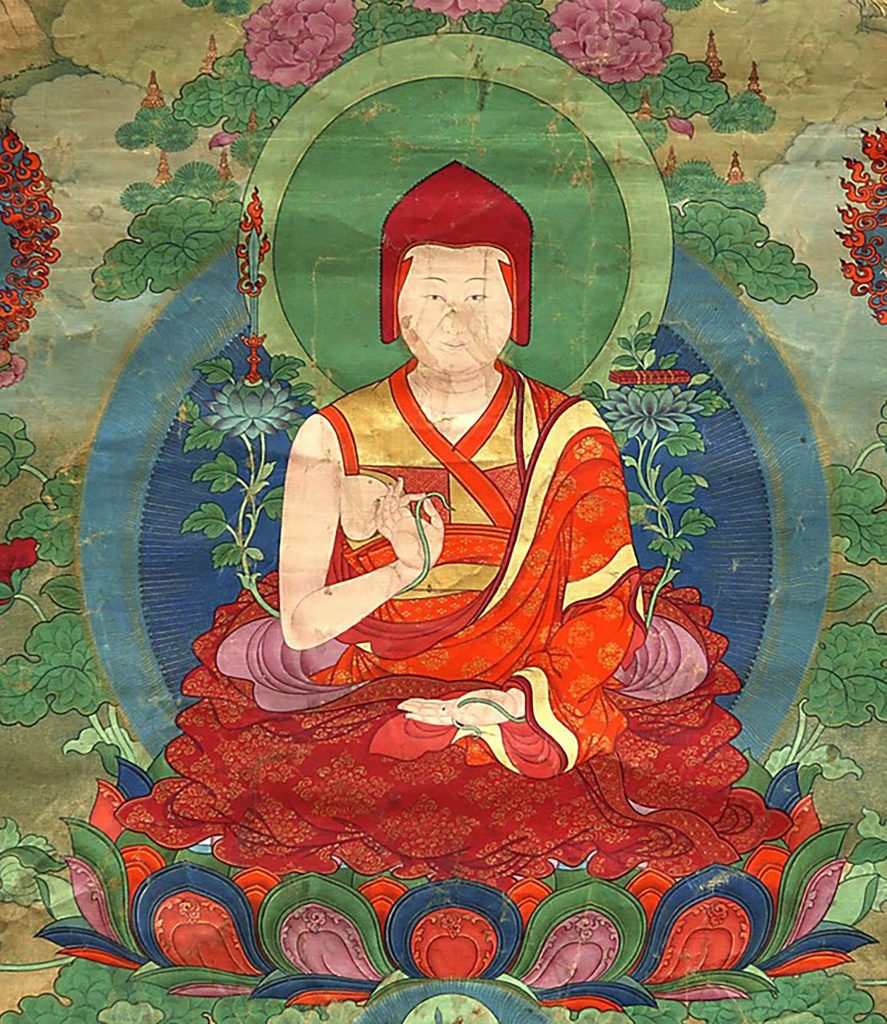Previous Lives
Disciple of the Dakinis
Khyungpo Neljor
 Terrifying flesh-eating women are not an element commonly associated with stories of devotion, but Khedrup Khyungpo Neljorpa’s life was never destined to be anything but extraordinary. Born in 1050 CE into the Khyungpo clan in Eastern Tsang, Tibet, Khyungpo Neljor would go on to receive a wide breadth of teachings and practices, most notably from mahasiddhas and dakinis such as Niguma and Sukhasiddhi. He would also become the founder of the Shangpa Kagyu tradition, one of the 16 sub-sects of the Kagyu school, as well as a prolific founder of monasteries.
Terrifying flesh-eating women are not an element commonly associated with stories of devotion, but Khedrup Khyungpo Neljorpa’s life was never destined to be anything but extraordinary. Born in 1050 CE into the Khyungpo clan in Eastern Tsang, Tibet, Khyungpo Neljor would go on to receive a wide breadth of teachings and practices, most notably from mahasiddhas and dakinis such as Niguma and Sukhasiddhi. He would also become the founder of the Shangpa Kagyu tradition, one of the 16 sub-sects of the Kagyu school, as well as a prolific founder of monasteries.
Khyungpo Neljor was just 13 years old when he began his education, first receiving Bön teachings and later, in the Dzogchen tradition as well. However, he eventually grew dissatisfied with the instructions available in Tibet at the time and so he set out on a long journey to Nepal in search of more teachings. There, he came under the tutelage of important Nepali masters and serving as an attendant to some of them, he received many wondrous teachings and tantric initiations from the Kriya and Yoga Tantras. But of all his teachers, Khyungpo Neljor is perhaps best remembered for receiving the Six Yogas of Niguma from the mahasiddha herself.
It has been said that on his travels, Khyungpo Neljor carried with him a lot of gold to be given as offerings to the teachers he came across, to create the merit for him to receive instructions, teachings and oral transmissions. During one such journey in India, he set out in search of the master Niguma, who was the sister of the mahasiddha Naropa.
Eventually, Khyungpo Neljor came across Niguma in the Sosadvipa charnel grounds of East India. She had, by then, attained the rainbow body and become the leader of dakinis. Khyungpo Neljor discovered her in the form of a naked yogini, floating high in the sky. She had an extremely dark complexion and a terrifying expression, and held a trident and skull cup. Her body was adorned with bone ornaments and her appearance shifted, sometimes appearing as many different dakinis and sometimes as just one. Upon sight, Khyungpo Neljor instantly knew he was in the presence of the famous Niguma and he prostrated while requesting for teachings.
However, this seemed to irk Niguma, who declared herself a flesh-eating dakini and she threatened to eat him. Undeterred, Khyungpo Neljor repeated his request and Niguma agreed, only if he offered gold to her. Khyungpo Neljor then offered her a bag of gold, which the dakini took and tossed into the nearby forest without so much as a glance in the direction of where it landed. She then glared into the sky to summon her entourage, who descended with offerings and materials. Niguma then proceeded to initiate Khyungpo Neljor into the Six Yogas of Niguma. He would go on to have auspicious dreams, which Niguma herself explained to him.
In the course of his extensive travels, Khyungpo Neljor met many great teachers including the Indian master, pandit and scholar Atisha Dipamkara Shrijñana. They compared Sanskrit texts that Khyungpo Neljor had collected while in India, with those that belonged to Atisha himself. Atisha confirmed Khyungpo Neljor’s texts as authentic and suggested that they be translated.
It is said that in his lifetime, Khyungpo Neljor founded 108 monasteries throughout Tibet. However only two are known to us today, Chakar which stands in Penyul and Zhangzhong Dorjeden of the Shang Valley.
In order to have established 108 monasteries, support for Khyungpo Neljor must have been widespread. Unsurprisingly, given this strong support, it was inevitable that he would eventually be met with resistance from jealous monks. Some are said to have taken up arms against him, and Khyungpo Neljor had to manifest a phantom army to defeat them in battle. It is also recorded that Khyungpo Neljor engaged in spiritual battles with various non-human entities that were obstructing the spread of the teachings.
This illustrious master entered clear light death meditation in 1127 CE. According to tradition, as befitting a lama of his reputation and stature, he was cremated and his ashes are reported to have manifested many relics. His disciples have since proliferated his teachings that became the foundation of the Shangpa Kagyu tradition of Tibetan Buddhism.
